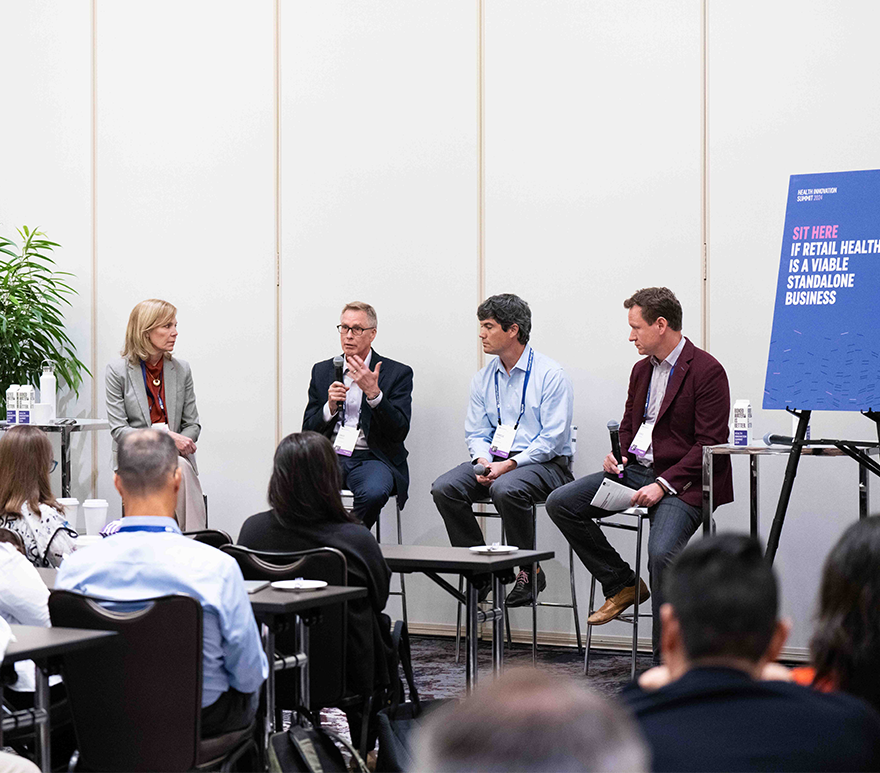There’s no shortage of challenges facing the healthcare industry. Clinician burnout and workforce shortages. Rising costs. Increased competition. Eroding consumer trust. But instead of handwringing, attendees at the 2024 Oliver Wyman Health Innovation Summit convened to share ideas for putting the industry on more stable footing.
Our earlier coverage of the Summit showcased how artificial intelligence can radically influence patient care and accelerate new drug discoveries. We also spotlighted efforts by leading organizations that are deploying AI and redesigning workflows to not only eliminate unnecessary tasks but bring the joy back to practicing medicine. And we examined ways organizations can make health equity a bigger part of conversations around innovation and transformation.
Beyond those high-level talks from the main stage, the Summit featured a number of Executive Sessions on topics ranging from workforce to industry consolidation. Below we recap a few of those conversations. We’ll have additional coverage in the coming weeks.
Using technology to ease workforce woes
There was “too much stupid” stuff in his day. That’s why David Kim, MD, said he became a “meeting” doctor. Now CEO of the MemorialCare Medical Foundation and Executive Vice President of Clinical Institutes MemorialCare Health System, Kim is eager to see how technologies like artificial intelligence can help doctors return to doing what they love — clinical care. It’s critical, he said, that organizations learn from the troubled rollout of electronic health record systems and ensure that AI shows value in order for clinicians to embrace it.
Jennifer Mensik Kennedy, President, American Nurses Association, agreed, adding that AI can be an enabler to keep nurses in the workforce by automating routine tasks. Being able to support nurses and take some of the load off their day-to-day routine will help ease the burnout rate, she said.
And just as healthcare organizations and clinicians are learning to use AI, so too are regulators, noted Tina Shah, MD, Chief Clinical Officer, Abridge. It is incumbent upon the industry to share as much knowledge as possible with regulators to build trust and ensure that any new guardrails don’t hamper innovation, she added.
Primary care is dead. Long live primary care!
It’s a question on the minds of a lot of health system leaders — how can we save primary care? First and foremost, it’s about building a trusted relationship with patients, panelists said during a session on the topic. Part of that relationship building is leaning on primary care physicians to act as an advisor who helps patients navigate care for their medical needs, suggested Brent Davis, Chief Financial Officer and Chief Operating Officer of AdventHealth’s Primary Health Division. Primary care can also tailor solutions for the unique needs of specific populations, like the underinsured, Medicaid beneficiaries, and rural residents, said Tom Lee, MD, CEO of Galileo.
Mary Jane Favazza, CEO, CloseKnit said that primary care providers must embrace an omnichannel approach. If patients and providers prefer telehealth for some visits but in-person for others, organizations need to make those available. She added that providers, who often deal with a multitude of quality metrics, must work with payers to make capturing that data easier; it needs to be built into the workflow more seamlessly.
Assessing the track record of industry consolidation
Whether it is regional players combing forces to gain scale or large national players coming together, mergers and acquisitions have been on the upswing over the past few years. In many cases, the jury is still out on the success of that consolidation. In some cases, M&A is driven by a lack of alternative solutions for struggling providers, especially in rural or low-access areas, said Rob Lemos, SVP of Strategy and Growth, Millennium Physician Group. M&A can be a lifeline and help drive providers towards value-based care.
But alternatives are out there, said Rondy Jennings, Managing Director, Goldman Sachs. Joint ventures and non-traditional partnerships will continue as organizations realize that they don’t need to own and operate everything. For instance, partnering for urgent care. Regardless of the strategy, being successful requires a clear vision on why a partnership and merger is necessary. Leadership from the board to the C-suite needs to be visibly committed to the strategy and they must lay out a clear integration plan, said Sandra Clarke, Executive Vice President and Chief Operating Officer, Blue Shield of California. And, critically, doing due diligence on the regulatory environment is a must.
What’s the future of retail health?
Retail health has been in the news a lot lately. Some retailers have slowed or even shuttered clinics while others continue to expand them. Figuring out the right business model and finding ways to integrate with other providers is a challenge. But retail health is an essential part of the healthcare landscape, said Marcus Osborne, Executive Chairman, RightMove. Retailers know how to engage consumers effectively, said Osborne, who previously served as Senior Vice President of Health Transformation at Walmart. He noted that consumers engage with their local Walmart store far more frequently than they do their primary care doctor.
The pandemic reinforced the idea that consumer engagement is key, added David Fairchild, MD, Chief Medical Officer, Retail Health, and Associate Chief Medical Officer, CVS Health. Consumers started expecting even more convenience from providers. Retail clinics can build more trust with consumers by acting as the quarterback for their care, said Brooke Brownlow, Group Vice President of Total Rewards and Wellness, H-E-B. By engaging in hyperlocal partnerships, retailers can help consumers navigate the complex web of healthcare services if they need more specialized care.
Showcasing innovators
Other organizations presenting at the Summit detailed how they are bringing innovation to the market, whether that’s data analytics or addressing the obesity epidemic. Oliver Wyman’s Jim Fields provides some highlights in this video:
Innovation In Action Showcase
Samuel Chiang, Kristen Hefferan-Horner, Derek Lukin, and Sean Mcauliffe contributed to this article.


